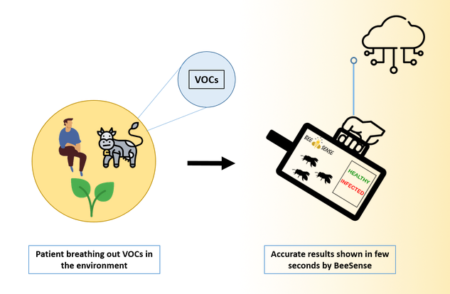Tree bark fighting MRSA, bees detecting Covid, ultrasound opening the brain, and more
12 May 2021
Posted by Andrew Kantor
Opening the blood-brain barrier
Georgia researchers — from Georgia Tech and Emory — have tackled the issue of getting RNA-based drugs to the brain. Yeah, RNA is great stuff, but it can’t get through that pesky blood-brain barrier. (Hence the term “barrier.”) But those Georgians found a trick: ultrasound, nanoparticles, and microbubbles.
First, the meds are packed into “robust nanocarriers,” about 100 nm across … but still too big for that barrier. Then microbubbles are added to the bloodstream. And then the ultrasound comes into play.
“Focusing multiple beams of ultrasound energy onto a cancerous spot caused the microbubbles’ vibrations to actually stretch, pull, or shear the tight junctions of endothelial tissue that make up the blood-brain barrier, creating an opening for drugs to get through.”
So far, of course, it’s just in the lab — but it worked, and now they’re planning to move ahead to get it to the clinic.
You need this immunization training
It’s coming up fast, but there’s still time to register for the hottest immunization courses around!
For technicians: GPhA’s Immunization Delivery Training for Pharmacy Technicians is on Saturday, May 22, from 9:00am to noon, offering six (6) hours of that sweet, sweet CE credit (that includes the online self-study).
For pharmacists: APhA’s Pharmacy-Based Immunization Delivery: A Certificate Program for Pharmacists is Sunday, May 23 from 8:00 a.m. – 5:00 p.m. for 20 whoppin’ hours of CE credit (again, with self-study).
Both are held live at at GPhA’s World Headquarters in Sandy Springs. Click the links and register today!
Ready for Covid-22
Duke researchers have created what they call a “pan-coronavirus vaccine” — one they say protects against a variety of coronaviruses. Essentially it targets one particular binder on that infamous spike protein, and it’s a site that’s present on all the circulating variants of SARS-CoV-2 as well as other SARS-related bat viruses.
So far it’s been tested on monkeys … and it’s 100 percent effective.
Funky MRSA fighters
Barking up the right tree: Microbiologists in Manchester, England, England tested bark cloth — made from fibers harvested from the Mutuba tree in Uganda — and found that, when applied to a wound, it can stop the growth of a MRSA infection by more than 99 percent. (And harvesting the fibers doesn’t hurt the tree!)
“While there are anecdotal reports of bark cloth’s antibacterial properties within rural Ugandan communities, this research has tested and proved its efficacy against a specific and serious cause of wound infections.”
Sticky Swedes: Meanwhile, Swedish researchers have found a way to deliver vancomycin directly to a MRSA infection. Normally it has to be given intravenously because it can’t penetrate the skin, but by using a microneedle patch, the drug is delivered at the site of the infection, reducing the amount of drug needed and (hopefully) eliminating side effects.
The patch is placed on the skin at the site of infection. The barely visible microneedles are so small that they do not reach the pain receptors, which makes the treatment relatively painless.
Covid-detector buzz
Dutch researchers at Wageningen University have taught bees to detect the scent of the SARS-CoV-2 virus. And training — unlike with a dog or a child — only takes a few minutes.
Each time the bees were exposed to the scent from an infected sample, they received a sugar water solution reward. The bees extended their tongues to collect the sugar water solution. By repeating this action several times, the bees associated the sugar reward with the scent as the stimulus.
So yes, the bees stick out their tongues when they detect the virus.
But wait, there’s more: The startup company InsectSense has a prototype machine that both trains the bees and then allows them to be used for virus testing.

If at all possible, involve a cow
The pharma future is digital
A new survey of pharmaceutical execs found that most of them are looking to digital drug delivery for their products within the next decade.
What is digital drug delivery? “Smart injectors or inhalers; digital pills, or pill bottles that track usage; infusion pumps that interface with a diagnostic device; [or] connected delivery devices* that record/share data.”
In fact, a whopping 88 percent said that such digital devices are important for their plans, and 65 percent said they expect most of their drugs to be delivered digitally within a decade.
* Never ever mention the word “ransomware.”
Foreshadowing?
Flu: Looking forward to the fall — and the presumptive return of the flu — a new “quad test” is gaining ground that can tell if a patient has Covid-19, either influenza A or B, or RSV, in about half an hour.
Covid: The WHO classified the Covid-19 strain that’s devastating India as “a variant of global concern,” as it seems to spread more easily. Set your Google Alerts to “B.1.617”.
Botulism: The CDC has published its first-ever guidelines for the diagnosis and treatment of botulism.
Smallpox: Siga Technologies has asked the FDA to approve its intravenous treatment for smallpox, called Tpoxx.
Captain Obvious hits the pub
The cliché is true: Drunk people do stand closer together.
“We measured distance between the individuals via machine-learning methods that detect hands, arms, legs and head position for each person in the video. We used a bit of geometry to turn the pixel coordinates of people detected in the video into real-world distances based on objects of known size visible in the video.”
Updating the shrine
British conservationists restored the 12th century shrine of St Amphibalus in Hertfordshire, England, and included a modern addition to commemorate the 2020-21 restoration:



